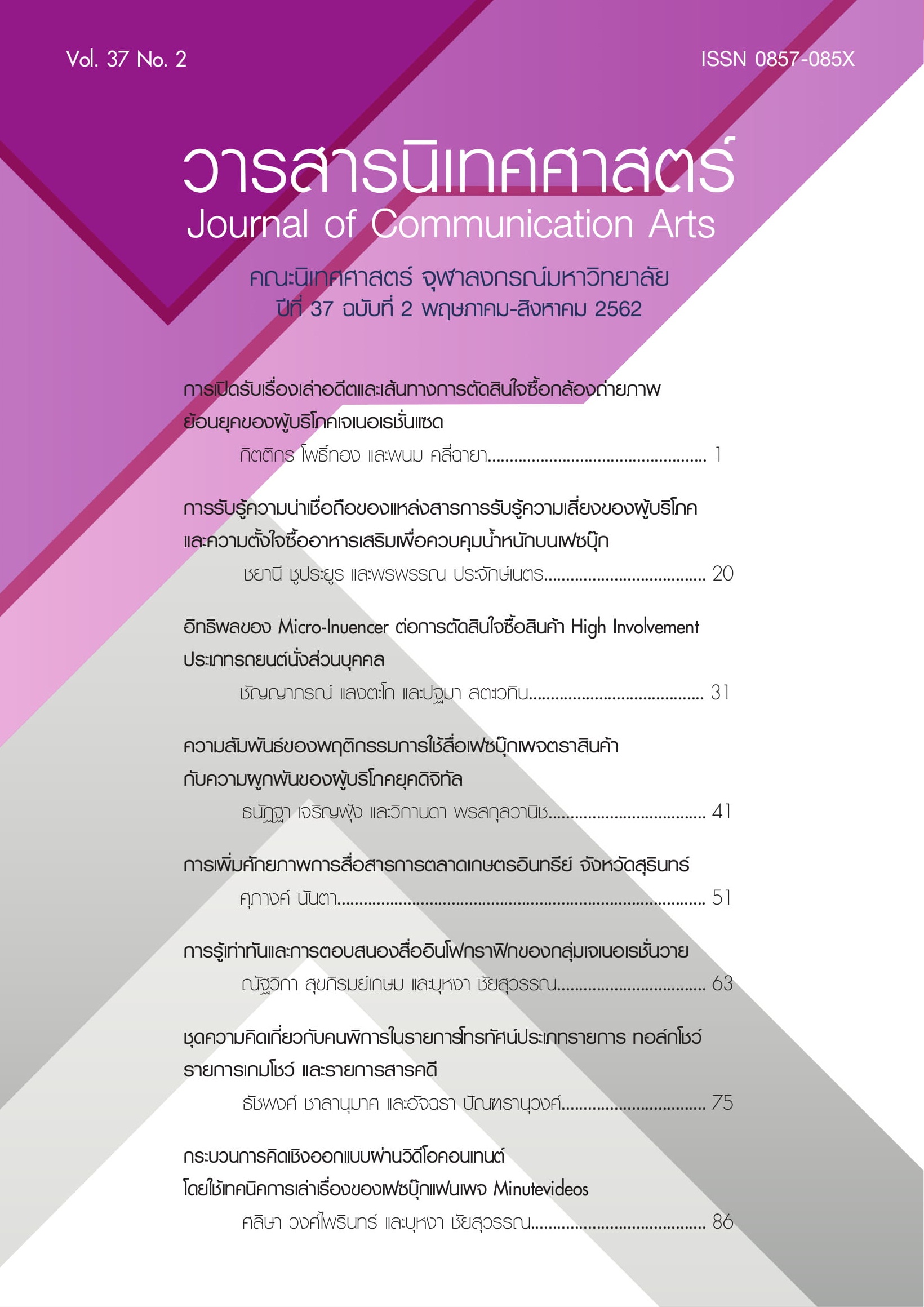Cognizance and Response to Infographic Media of Y Generation
Main Article Content
Abstract
The objective of the research was to study the behavior of Y Generation on the cognizance of and the response to Infographic Media. The study was done on the quantitative research using theonline questionnaire as the statistical tool. The online survey was practiced on 400 samples who had ever experienced the infographics. The results of the sampling would be statistically executed for the t-test, One Way ANOVA, and Pearson Correlation. The study indicated that more than half of the samplings were female at the ages of 26-30 mostly finishing bachelor degree and being private employees. The second one would be that of the students. The average monthly incomes would be at 15,001-30,000 baht and 30,001-45,000 baht respectively. The sampling group used online media daily. Most of them have been using online media for more than 10 years using at least two devices; mobile and computers. They have been using online media mostly through the search engine. At least 5 to 6 media were used. The secondary media used would be Chat Application. The internet access time could be the scattered one with the peaks at night; 6.01 am to 9 am., and 9.01 am. to midnight. From the hypothesis testing, it could show that different population variables of the Y generation would show different results of the cognizance except that of the gender variables. For the overall infographic media cognizance behavior, it would be at a high level. Actually, the samplings could cognize the matter of media chosen through producers’ visions. Secondarily, the samplings could cognize the impact and risk of online social media communication and they could think that infographics would be attractive for reading. Moreover, it was found that the different population variables of the matter receivers of the Y Generation could show different results for infographics media response except that of education levels. For overall infographic response behavior, it could be at the average level. Actually, when the samplings met some interesting matters in infographic social media they would press like on the Facebook. Secondarily, when they met the one they disliked they would ignore their reading for more details. When the sampling group met something interesting they would press like through Facebook, respectively. For the last hypothesis, it found that the infographic media cognizance behavior could relate to the response behavior to the infographic media of the Y Generation and it appeared at the average level with the identical relation.
Article Details
References
ณัฏฐาวรัต จีรรีชต์. (2558). พฤติกรรมการใช้เครือข่ายสังคมออนไลน์ของผู้บริโภควัยทำงานในเขตห้วยขวางกรุงเทพมหานคร. วิทยานิพนธ์ปริญญามหาบัณฑิต มหาวิทยาลัยธุรกิจบัณฑิตย์.
นุชจรินทร์ ชอบดำรงธรรม. (2554). อิทธิพลของสื่อโฆษณาในเครือข่ายสังคมออนไลน์ที่มีผลต่อกระบวนการตอบสนองของผู้บริโภค. วารสารศรีนครินทรวิโรฒวิจัยและพัฒนา (สาขามนุษยศาสตร์และสังคมศาสตร์), 3(6), 12-26.
เพ็ญพักตร์ เตียวสมบูรณ์กิจ และณรงค์ ขำวิจิตร์. (2559). ความรู้เท่าทันสื่อของผู้ใช้สื่อโทรทัศน์ไทยภายใต้ภูมิทัศน์สื่อโทรทัศน์ที่เปลี่ยนไป. วารสารการประชาสัมพันธ์และการโฆษณา, 9(1), 99-103.
ยุบล เบ็ญจรงค์กิจ. (2542). การวิเคราะห์ผู้รับสาร. กรุงเทพมหานคร: คณะนิเทศศาสตร์ จุฬาลงกรณ์มหาวิทยาลัย.
รสสุคนธ์ สกุลเมตตา. (2558). การรับรู้และการตอบสนองการสื่อสารการตลาดผ่านไลน์ออฟฟิเชียลแอคเคานต์ของเครือข่ายโทรศัพท์มือถือ. วิทยานิพนธ์ปริญญามหาบัณฑิต สถาบันบัณฑิตพัฒนบริหารศาสตร์.
วิภาดา พิทยาวิรุฬห์. (2557). สื่อดิจิทัลที่มีอิทธิพลต่อการตอบสนองของผู้บริโภคในการเข้าถึงข้อมูลทางการตลาด. วารสารบริหารธุรกิจศรีนครินทรวิโรฒ, 5(1), 80-96.
สุภารัตน์ แก้วสุทธิ. (2553). พฤติกรรมการรู้เท่าทันการใช้งานอินเทอร์เน็ต และการป้องกันตัวเองจากการละเมิดสิทธิส่วนบุคคล. วิทยานิพนธ์ปริญญามหาบัณฑิต จุฬาลงกรณ์มหาวิทยาลัย.
เอมิกา เหมมินทร์. (2556). พฤติกรรมการใช้และความคิดเห็นเกี่ยวกับผลที่ได้จากการใช้เครือข่ายสังคมออนไลน์ (Social Media) ของประชาชนในเขตกรุงเทพมหานคร. วิทยานิพนธ์ปริญญามหาบัณฑิต สถาบันบัณฑิตพัฒนบริหารศาสตร์.
DeFleur, M. L., & Ball-Rokeach, S. L. (1996). Theories of mass communication. London: Longman.
UNESCO. (2013). UNESCO global mil assessment framework. Retrieved April 15, 2018, from http://www.unesco.org/new/en/communication-and-information/media-development/media-literacy/unesco-global-mil-assessment-framework/


